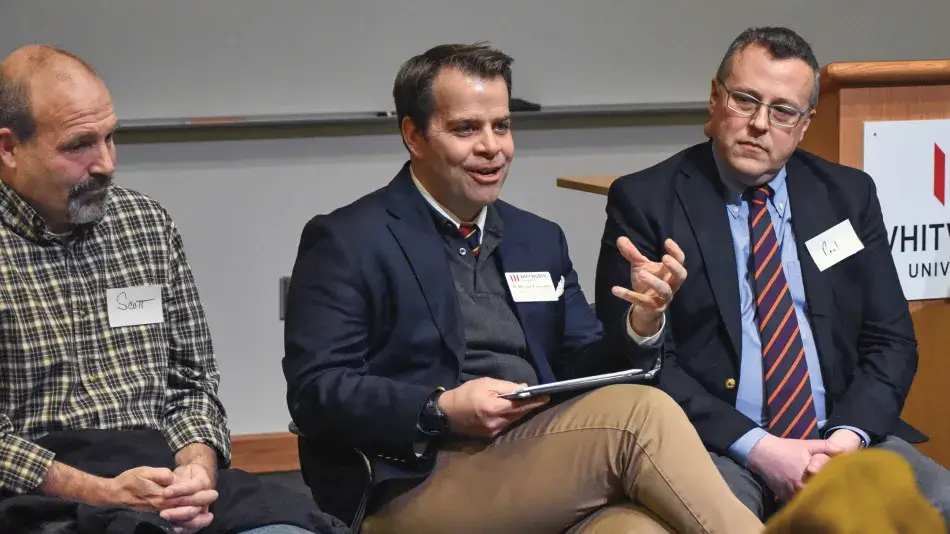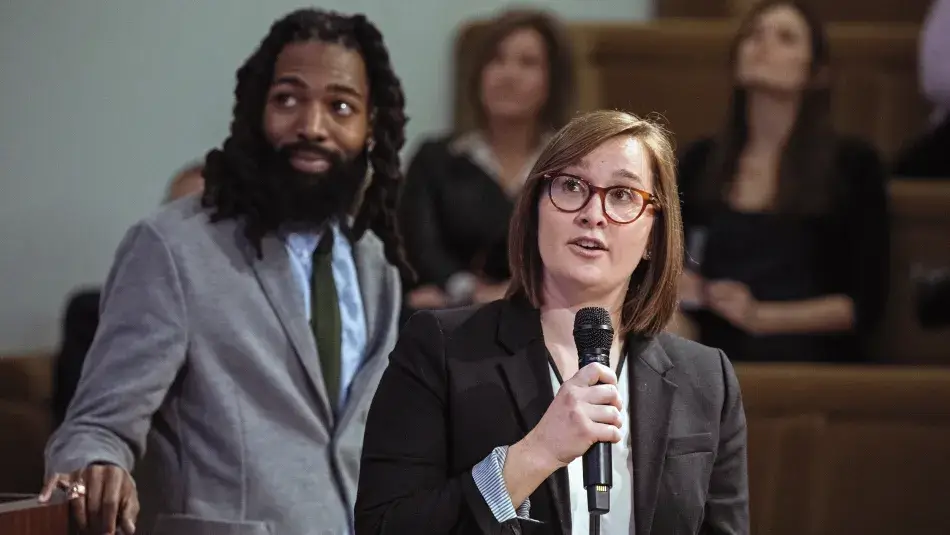Our Common Purpose
Strategy 1: Achieve Equality of Voice and Representation

Strategy 1: Achieve Equality of Voice and Representation
“Some folks feel the voices that count the most are those that have the power. And when I am my most negative, I feel the same way. . . . [But] democracy is about all voices counting. . . . How do we get those people to believe that we can make that change?”
—Ellsworth, Maine
Expand both the House of Representatives and the ways that people can vote for their representatives. Change how districts are drawn: first to eliminate partisan gerrymandering and then to make them larger, allowing several representatives per district. Amend the Constitution to allow for congressional regulation of campaign expenditures. Empower small donors and make campaign donations more transparent. Move from life tenure to single eighteen-year terms for Supreme Court justices. These are the eight recommendations of the Commission’s first strategy.
1.1
Substantially enlarge the House of Representatives through federal legislation to make it and the Electoral College more representative of the nation’s population.
When the framers of the Constitution designed the House of Representatives, they set a constitutional cap of 30,000 constituents per representative. With population growth, the House grew from 65 to 435 members in 1929, when Congress capped its size. With further population growth, the average Congressperson now represents over 747,000 constituents. Repealing the 1929 Permanent Apportionment Act and expanding the House will tighten the link between representatives and their constituencies and make the House more representative of the nation.
“[The] country keeps growing with its population and so it’s a lot harder to get the attention of your congressional representative now than it apparently used to be, way before any of us were born.”
—Spokane, Washington
To return the House to its original proportionality of 30,000 constituents per representative would require expanding it by over 10,000 members—an obviously impractical proposal. The House was designed for members who deliberate face-to-face. While the original proportions are no longer achievable, the goal of closer connections between members of Congress and constituents should not be.
This expansion will also have a salutary effect on the Electoral College. The framers designed the Electoral College to balance the influence of the population at large and of the states on presidential elections—and, among states, the influence of small and large. Demographic changes have shifted the delicate balance and increased the likelihood that a majority of the population and a majority of the states will make opposed choices. In the forty-four elections from 1824, when popular votes were first tabulated, through 1996, the winner of the presidency lost the popular vote in only two elections. In the five presidential elections since, it has happened twice, and demographic changes have only increased the likelihood of this outcome. An increasing frequency of such events would cast doubt on the legitimacy of presidential elections.
In 1790, the population of the largest state, Virginia, was twelve times that of the smallest state, Delaware. Now that ratio is sixty-nine to one (California to Wyoming). The vote of a Wyoming resident weights 3.6 times more heavily in the Electoral College than that of a Californian. Demographers project that the disparity between small states and large states will widen in the decades to come. By 2040, the population ratio between the largest state and smallest state is expected to be seventy-seven to one.25
Expanding the House mitigates but does not wholly correct the increased imbalances of power between more and less populous states. Nonetheless, it is a worthy start. How many seats should be added? The current Capitol Building could easily accommodate an additional fifty members. This should be the starting bid. The precise number should be established through vigorous discussion and debate.

1.2
Introduce ranked-choice voting in presidential, congressional, and state elections.
Most election outcomes in the United States are determined by winner-take-all electoral systems. The candidate who receives the plurality of votes—that is, more than any other candidate, though not necessarily a majority—wins the election. In some cases, the winning candidate must receive a majority of votes. Both variations of winner-take-all voting are used in state and congressional elections in the United States. On the presidential level, the Electoral College determines the overall winner. Most states use a winner-take-all model to allocate all of their Electoral College votes to the state’s popular vote winner; only Maine and Nebraska use a proportional system to allocate their Electoral College votes.
The winner-take-all model of voting presents serious shortcomings. In the case of plurality outcomes, when votes are distributed among three or more candidates, the winner of the election may be a candidate who is disliked by a majority of voters. With a vocal minority able to impose its will over a more moderate majority, candidates are incentivized to appeal to the political fringes, and third-party candidates face pressure not to run lest they split the vote. Requiring a majority outcome through run-off elections seeks to avoid or mitigate these pressures, but run-off elections are costly and participation is generally low.
There is an alternative: ranked-choice voting (RCV). Instead of choosing only one candidate, voters choose their preferred candidate and then rank their second choice, their third choice, and so on. After votes are tallied, the least popular candidate is removed, and that candidate’s supporters’ votes are allocated to their second choices. The process continues until a single candidate receives a majority of support. The reallocation of votes is tantamount to a run-off election, without the need for voters to show up at the polls a second time.
- Ranked-choice voting became law in Maine through a ballot initiative in 2016. It was used in the 2018 election to determine a majority winner in one of Maine’s two congressional districts. In 2020, Maine will become the first state to use ranked-choice voting in the presidential election.26
- In 2019, New York City residents elected to revise the city’s charter to establish ranked-choice voting for all primary and special elections. New York City is now among more than fifteen cities that use ranked-choice voting.27
Because second and third choices matter in the ranked-choice model, candidates have an incentive to speak to a broader group of voters. The result: more moderate candidates and campaigns, a more welcoming environment for third-party candidates, and greater confidence among voters that their votes are not being wasted or distorting the outcome.
1.3
Amend or repeal and replace the 1967 law that mandates single-member districts for the House, so that states have the option to use multi-member districts on the condition that they adopt a non-winner-take-all election model.
The number of congressional seats each state has is determined by the census. Yet states do have wide latitude to determine how the representatives allocated to them are elected, including how congressional districts are drawn. The Uniform Congressional District Act, passed in 1967, standardized the use of single-member districts (SMDs), in which each district sends a single representative to Congress. Prior to this, states had the option of drawing multi-member districts (MMDs), which were larger and sent more than one representative to Congress.
The 1967 law made sense at the time. The civil rights movement was in full swing, and there was concern that efforts might be made in the South to draw large multi-member districts with white majorities. In this version of gerrymandering, black residents in the South risked losing all or most representation in the House.
Many of the concerns that motivated the 1967 law are still valid today. Within the framework of winner-take-all voting, MMDs would mean a step backward for equal voice and representation. State legislatures could—as they sought to do decades ago—draw large gerrymandered districts that dilute minority votes, both racial and ideological. States that use winner-take-all voting should not be permitted to draw MMDs.
Ranked-choice voting, however, changes the equation dramatically. If MMDs were coupled with ranked-choice voting in congressional elections, they would encourage the participation of a wider array of candidates, each of whom would have to appeal to a more heterogeneous bloc of voters. Instead of exacerbating the distortions of winner-take-all voting and drowning out minority votes, MMDs would amplify the representational benefits of ranked-choice voting and signal a victory for equal voice and representation.
- Though the 1967 law prohibits the use of MMDs in congressional elections, they are still permitted in state elections. Ten states today have at least one legislative chamber with MMDs.28
- In Illinois, from 1870 until 1980, the state legislature used three-member districts. Voters were allocated three votes, which they could distribute among candidates however they chose: three for one candidate, two for one and one for another, or one each for three individual candidates. After it was abolished, a bipartisan task force led by Republican former Governor Jim Edgar and Democratic former Representative Abner Mikva called for its reinstatement, saying it created a more representative and effective legislature. The system previously used in Illinois might serve as a model for multi-member congressional districts.
1.4
Support adoption, through state legislation, of independent citizen-redistricting commissions in all fifty states. Complete nationwide adoption, through federal legislation, that requires fair congressional districts to be determined by state-established independent citizen-redistricting commissions; allows these commissions to meet criteria with non-winner-take-all models; and provides federal funding for these state processes, with the goal of establishing national consistency in procedures.
In most states, the party in control of the legislature has an incentive to redraw districts in ways that benefit that party.29 Through concentrating the opposing party’s voters in one district (“packing”), or distributing them among multiple districts to dilute their votes (“cracking”), parties are able to load the electoral dice in their favor. Governor Elbridge Gerry of Massachusetts pioneered this practice in 1812 by signing into legislation a district that resembled a salamander. His name has become immortalized as a synonym for political manipulation: gerrymandering.
“I think at the local and state level, the concern that I kind of have with Farmville is the way the maps are set up, right? . . . We’re in a rural area, there’s such a large district that Farmville tends to be grouped in with other localities that are larger and tend to have a larger pull.”
—Farmville, Virginia
Although gerrymandering has existed for more than two centuries and is an activity in which both major parties partake, it has in recent decades, with the advent of new scientific and mathematical tools, become more commonplace and brutally effective. Consider the case of North Carolina, which has egregiously gerrymandered districts. In the 2018 midterm elections, Republicans won the statewide popular vote by only 2 percent (50 to 48 percent), but nonetheless held onto ten of the state’s thirteen congressional seats.30
In response to the rise of partisan gerrymandering, some states have recently chosen to turn over the job of redistricting to independent commissions. Arizona was one of the first states to do so. The move met resistance in the courts, but in 2015, in Arizona State Legislature v. Arizona Independent Redistricting Commission, the U.S. Supreme Court ruled 5–4 that independent redistricting commissions are constitutional. Similarly, in 2018, feeling encouraged by the popular reaction to a proposal she had posted on Facebook, a Michigan citizen launched a statewide ballot initiative to transfer responsibility for redistricting from the state legislature to an independent commission. The ballot initiative passed 61 to 39 percent.
Independent commissions are not the only way to make redistricting fair. Other approaches to the problem exist, and we don’t intend to foreclose them.31 But our recommendations acknowledge that the most effective reforms to date have involved independent commissions, which now exist in California and Arizona and soon will be in effect in Ohio, Utah, and Michigan, among several other states.32

1.5
Amend the Constitution to authorize the regulation of election contributions and spending to eliminate undue influence of money in our political system, and to protect the rights of all Americans to free speech, political participation, and meaningful representation in government.
Numerous factors contribute to the pervasive sense among Americans that their voices are not being heard: that “one dollar, one vote” has displaced “one person, one vote.” When asked to cite the factor that weighs most heavily in their indictment, participants in the Commission’s listening sessions achieved a clear consensus: big money in politics. Seventy-six percent of Americans believe the government is run by “a few big interests looking out for themselves,” and 77 percent say there should be limits on the amount of money individuals and organizations can spend on campaigns.33
Worries about the influence of money in our political system are not new, but the floodgates burst open and the concerns intensified in 2010 with the Supreme Court’s landmark 5–4 decision in Citizens United v. Federal Election Commission. In this decision, the Court determined, on free-speech grounds, that corporate entities may give unlimited amounts of money to independent political committees. Big donors get a level of access to major policy-makers that rank-and-file constituents cannot, and now more than ever we see that access reflected in policy outcomes—to the detriment of ordinary citizens.
One of the greatest obstacles to restoring faith in politics and governance, big money is now a fact of life in American politics. The current jurisprudence around election spending, with its weighty emphasis on the rights of corporations, fails to protect the rights of all Americans. The current makeup of the Supreme Court makes it unlikely that the decision in Citizens United will be overturned, which leaves only one option: a constitutional amendment.

Support for such a move is growing. Twenty states have already passed preratification legislation in support of a constitutional amendment that would allow for congressional regulation of election spending. Though nonbinding, the legislation passed by these states sends a strong signal to Congress about the will of the American people. Organizations such as American Promise are coordinating efforts to have an amendment passed by 2026.
The framers designed constitutional amendment to be difficult: they intended it to be a solution of last resort for matters of only the highest national importance. Yet they also understood that the Constitution is not perfect. We have amended it twenty-seven times already, and now we must do so again.
1.6
Pass strong campaign-finance disclosure laws in all fifty states that require full transparency for campaign donations, including from 501(c)(4) organizations and LLCs.
The total cost of the presidential and congressional elections in 2016—that is, the combined expenditures of all campaigns, political parties, and outside sources—has been estimated at $6.3 billion. That is a staggering number, yet the price tag itself is not the only problem. Political money in the United States today is not only big but also dark. Big money’s erosion of our institutions’ legitimacy is exacerbated when voters do not know where the money is coming from or whose interests it serves.
As long as Citizens United defines the jurisprudence around election spending, big money will be here to stay. Yet in its decision, the Court did leave one avenue for reform open: the use of strong disclosure laws to make dark money less dark. While disclosure does not stanch the flow of money, there is evidence that it deters some funding and mitigates the impact of other special-interest spending. At bottom, voters have a right to know the identities of those running political ads and shaping campaigns.
In 2010, Congress came close to passing a major disclosure bill that would have helped voters understand who is paying for campaign ads. The bill, which would have become the DISCLOSE Act, passed the House and got fifty-nine votes in the Senate, but was killed on a filibuster.
More recently, states such as Colorado and New Jersey have acted effectively to adopt strong disclosure laws that require transparency around political expenditures, including those that pass through LLCs and 501(c)(4) organizations, which function as vehicles for much of the dark money that enters politics today. Some states have even required actual donors’ identities to appear in campaign ads. In designing such legislation, however, states should also be sensitive to the legitimate privacy concerns of small donors.
1.7
Pass “clean election laws” for federal, state, and local elections through mechanisms such as public matching donation systems and democracy vouchers, which amplify the power of small donors.
Where voice and representation are concerned, the American political landscape today resembles a David-versus-Goliath struggle between the ordinary voter and well-funded special interests. Weakening Goliath by mitigating the power of big money is one way to tilt the playing field back in favor of the citizen. That’s what a constitutional amendment that authorizes congressional regulation of election spending would do. But another approach is to amplify the power of small donors: that is, to strengthen David.
When it comes to empowering small donors, policy-makers have a menu of options to choose from. One popular and road-tested vehicle for empowering small donors is a public matching donation system, in which small donations to political campaigns are matched by the municipality or government in question—sometimes even with a multiple of the original donation. New York City, for example, has a public-financing system that matches small donations to candidates by a factor of six. A $10 donation from a NYC resident, therefore, is worth $70 in the candidate’s hands. In January 2020, lawmakers in New York State passed into law a public financing system modeled on that of New York City.
Democracy vouchers are another, newer idea: citizens receive campaign-donation vouchers that they can then give to their preferred candidate to be redeemed as cash. Seattle has pioneered this approach. Residents of the city receive vouchers worth $100 that they can give to a candidate or candidates of their choice. So far, the results are promising: a 2017 report estimated that 84 percent of democracy-voucher donors in Seattle had never contributed to a political campaign before.34
Yet another option is the public financing of campaigns. Today, fourteen states provide candidates with some form of some public financing, and some—Arizona and Maine among them—go so far as to offer full funding.35 Typically, in order to receive public financing, a candidate must commit not to accept large amounts of money from single groups or individuals. One benefit of public-financing systems is that they tend to support greater diversity, both among donors and among candidates.36
1.8
Establish, through federal legislation, eighteen-year terms for Supreme Court justices with appointments staggered such that one nomination comes up during each term of Congress. At the end of their term, justices will transition to an appeals court or, if they choose, to senior status for the remainder of their life tenure, which would allow them to determine how much time they spend hearing cases on an appeals court.
The Supreme Court holds tremendous power in American society. Although the justices are not directly elected by the people, they are connected to the people indirectly: they are nominated and confirmed by the president and senators the people have elected. The framers intended Supreme Court justices to serve life terms (“during good behavior”), yet with increased lifespans since the eighteenth century, a justice may serve for a generation or longer, often decades more than the framers are likely to have imagined. Add to the mix the deepening polarization on the Court, in which most high-profile and high-impact decisions are 5–4 rulings, and the actuarial luck of the draw, with one president filling many Supreme Court vacancies and another president few or none, and it is no wonder the power to make Supreme Court appointments has become such a contentious part of the presidential election process.

The remedy: abolish life terms. The Constitution stipulates that Supreme Court justices serve during good behavior, but it does not explicitly establish the type of judicial work done during a life term nor prevent Congress from enacting terms. Federal legislators have the power to enact eighteen-year terms of work on behalf of the Supreme Court, with justices transitioning at the end of the term to the lower courts with undiminished salary for the remainder of their careers. Justices would also have the option of transitioning to senior status. (In the current system, retired Supreme Court justices automatically transition to senior status.)
Enacting eighteen-year terms for Supreme Court justices would go a long way toward depoliticizing the appointment process, yet for this remedy to be truly effective it would need to be paired with regular appointments: one Supreme Court justice nominated during each term of Congress. With each president responsible for two nominations per term, the nomination process would become less partisan. More important, eighteen-year terms married to regular appointments would help move the Court toward a less partisan future, restoring its legitimacy as an independent arbiter of justice.
